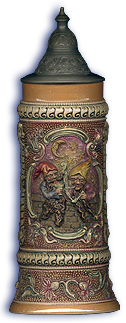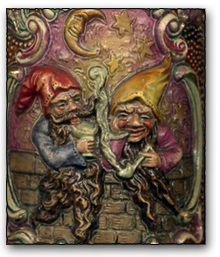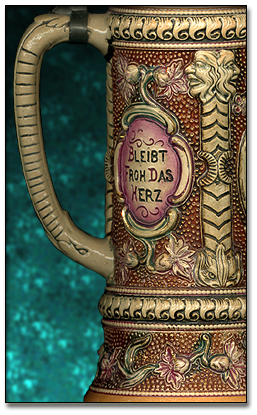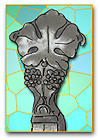|
April Stein of the Month: |
|
Last Month | Archives | Home  |
~ Heinzelmännchen Stein by Diesinger ~

This month we look at a wonderful, half-liter relief stein featuring two, richly-painted Heinzelmännchen by Diesinger. They're having a wonderful time smoking and drinking under the moon and stars.
This stein is mold #649 and is called, "Two gnomes on a wall." The sayings inside the two cartouches are:
"Bleibt Froh Das Herz" and "Bei Trunk U Scherz."
Literally translated, this means
"Happy stays the heart - With drinking
and joking"
A lyrical interpretation would be "The heart stays content - With drink and
merriment"
Although there is some known and documented information about the Diesinger factory and its works, it remains "shrouded in mystery." It's existence is a fact, but uncovering clues to Adolf or Karl Diesinger's work has been difficult.
Hans Bühler, of the Marzi & Remy factory, was quoted as saying, "Mr. Diesinger came from Bavaria and operated a pottery and pewter works in Höhr, on the Schützenstrasse. He basically produced salt-glazed household articles, but also decorative ceramics of majolica in the style of the porcelain industry."
As of today, no one has ever found a Diesinger name or logo on steins made in the Diesinger factory of Höhr which operated from around 1860 to 1910. Even so, the Diesinger steins have a number of characteristics that make their pottery easier to spot. This month's stein is one of the more easily recognizable Diesinger steins.
 DRGM
154927 (also DRGM 250635) patent mark. "Duetsches Reich Gebrauchmuster"
is a patent claim, protecting the manner in which Diesinger decorated his
pottery pieces. We know of two different claims. The first, DRGM 154927, was
issued to Adolf Diesinger in April, 1901 for "machining to the exact and
sharp demarcation of colors on porcelain, ceramic and majolica, etc., consisting
of a hand-worked relief of all figures and decorative representation." The
second, DRGM 260635, was issued to protect the manner in which the lid was
attached to the body. The lower hinge was made as part of the stoneware. This
means there is no pewter strap around the handle in these steins.
DRGM
154927 (also DRGM 250635) patent mark. "Duetsches Reich Gebrauchmuster"
is a patent claim, protecting the manner in which Diesinger decorated his
pottery pieces. We know of two different claims. The first, DRGM 154927, was
issued to Adolf Diesinger in April, 1901 for "machining to the exact and
sharp demarcation of colors on porcelain, ceramic and majolica, etc., consisting
of a hand-worked relief of all figures and decorative representation." The
second, DRGM 260635, was issued to protect the manner in which the lid was
attached to the body. The lower hinge was made as part of the stoneware. This
means there is no pewter strap around the handle in these steins.
Handle - Stylized, snake-like motif. There are approximately 22 documented handle styles which match the DRGM marked steins.
Thumblift - The oak leaf
pattern design (graphic shown) is an often-used motif on Diesinger steins
Diesinger steins
Columns - These are usually found between cartouches and often portray a double-headed figure at the top with a rococo, "C" break in the center and ends with a bird-like, grotesque creature at the bottom.
Cartouches - The "frame work" which surrounds the central artwork or sayings on the sides. These are usually highly decorated.
Stippling - A textured style
that is usually seen as raised bumps, like on a basketball (as seen on featured
stein). Diesinger also used a mottled, sponge-looking texture on some pieces (at
right). This was dug into the pottery and not raised from the surface. These textures were used for backgrounds and detail work.
Quite often, you'll find the stippling finished with gold highlights as the one
shown.
from the surface. These textures were used for backgrounds and detail work.
Quite often, you'll find the stippling finished with gold highlights as the one
shown.
Two other characteristics which help identify a Diesinger stein are rows of beading near the top and/or bottom, and repetitive, rococo-styled design work.
Diesinger steins are a great item to collect. There are a wide variety of high-relief styles and colors at a mid-range price that is affordable to many. You can find genre styling, the irrepressible Heinzelmännchen, character steins and more. For those who'd like to learn more about Diesinger steins, read "A Collector's Guide to Diesinger Steins" by SCI members, Patricia and Eugene Manusov. Keep a look out for this book as a great reference purchase item. SCI members can also borrow the book from The Beer Stein Museum Research Library and Archives. Happy collecting!
Acknowledgements: Patricia L. & Eugene V. Manusov, A Collector's Guide to Diesinger
Steins, Bristol Press, 1991
Scanning, photography and graphics provided by Ginger Williams - property of SCI
© Stein Collectors International 1996-2000